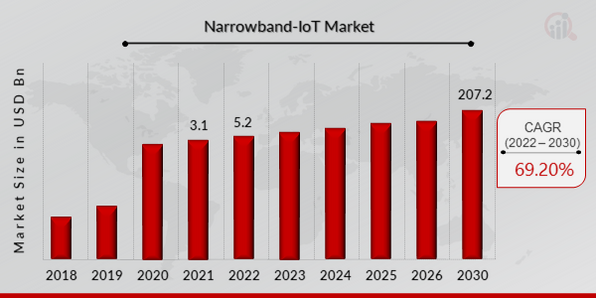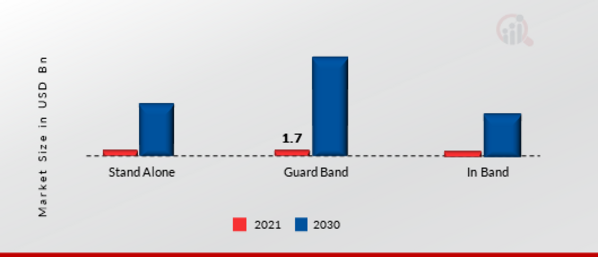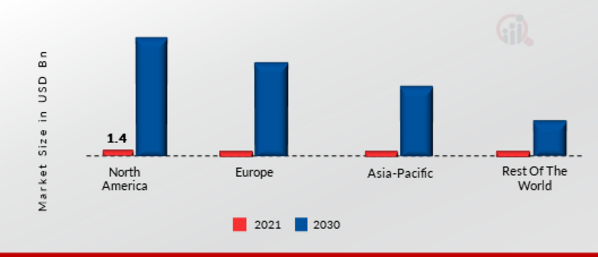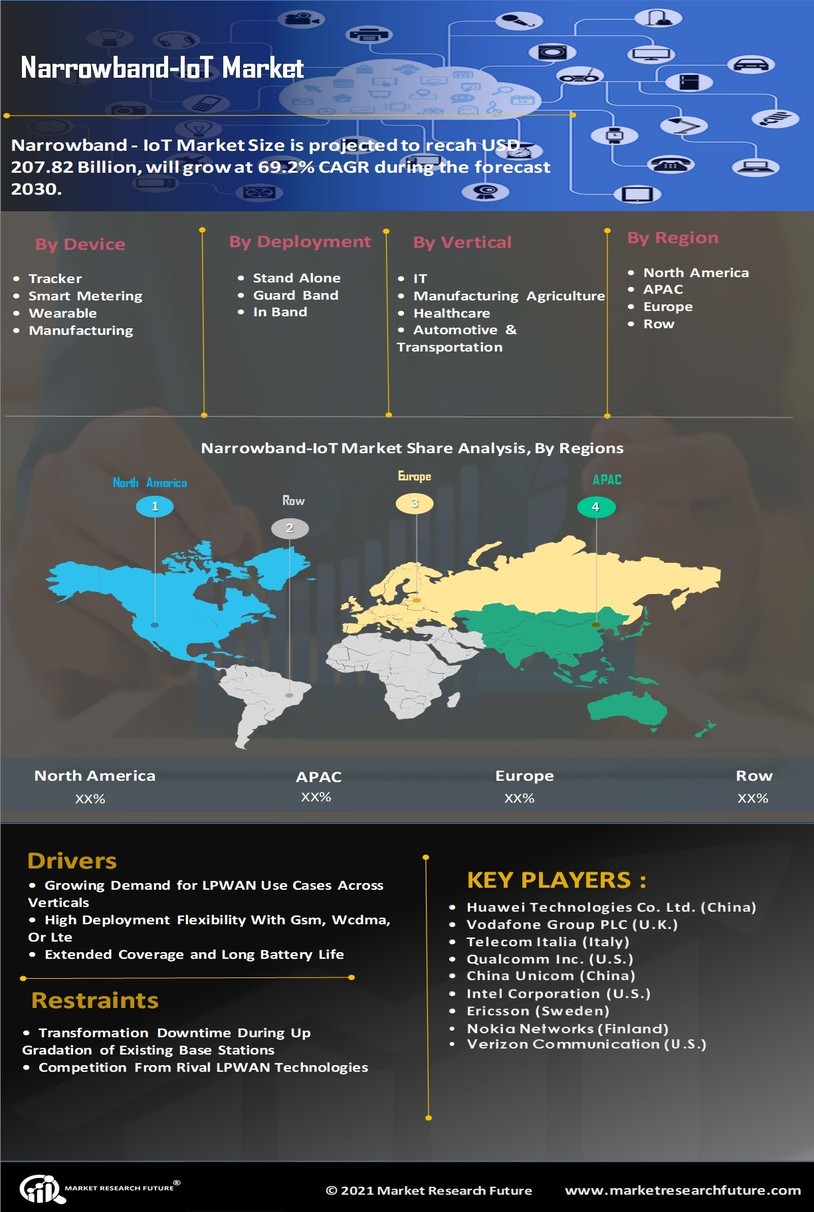Narrowband-IoT Market Overview
Narrowband-IoT Market Size was valued at USD 3.1 billion in 2021. The narrowband-IoT market industry is projected to grow from USD 5.2 billion in 2022 to USD 207.2 billion by 2030, exhibiting a compound annual growth rate (CAGR) of 69.20% during the forecast period (2022 - 2030). More and more tech firms and telecommunications service providers are anticipated to develop NB-IoT devices and roll out services as a result of the fast expanding applications for NB-IoT technology, serving as the primary market drivers for growth over the projected period.
Figure 1: Narrowband - IoT Market Size, 2022-2030 (USD Billion)

Source: Secondary Research, Primary Research, MRFR Database, and Analyst Review
Narrowband-IoT Market Trends
Increasing IoT application in various sectors, as well as the ability of Narrowband IoT (NB-IoT) to penetrate deep underground will propel market growth
IoT devices could be installed underground and underwater thanks to the NB-IoT network's ability to reach deep below and in confined spaces. It is the responsibility of telecom service providers to provide network connectivity, including standalone, in-band, and guard-band modes, for the connected IoT devices that are installed as parts of the networks. For instance, the project was led by Vodafone, Idrica, and the Gandia city council, and on December 9, 2021, Gandia became the first smart water city in Spain with NB-IoT technology used to remote metering to communicate water usage statistics. Additionally, connections are now possible in nearly every industry thanks to Internet of Things (IoT) breakthroughs, including consumer electronics, retail, and healthcare. Currently, there are about 15 billion gadgets in use, and by 2025, there will be 75 billion smart devices, an increase of 400%. A lot of data will be produced by these intelligent gadgets, which can be used for real-time data monitoring. Due to these sensors' low price, commercial use of IoT has significantly increased. The market for NB-IoT is also being driven by rising need for a smarter, greener environment, decreased power usage, and smoother communications through increased connection. Thus, this factor is driving the market CAGR.
Advances in mobile IoT network solutions, such as Nb-IoT from mobile operators, provide a scalable, secure, and standardized way to connect smart city assets that provide a wide range of services in a sustainable manner. Because such technology is specifically designed to meet the needs of smart cities, the economics of using such technology is leading to improvements in value chain standardization around networks and components. Parking sensors, for example, are frequently deployed in locations without access to a power supply and are expected to serve their entire life span with the installed battery power while still transmitting the required data by leveraging NB-IoT batteries have the potential to last 10 years because they are typically designed to send a few hundred bytes of data that is handled efficiently, maximizing capacity while minimizing power consumption. Nb-IoT also provides two-way communication, remote access, and large downloads to accommodate firmware updates. For instance, Sensonoes, a smart waste management solution provider based in the UK, announced in July 2019 that it had chosen Twilio, Caa NB-IoT due to its reliability, ease of management, and coverage to manage its smart sensor in North America. Thus, it is anticipated that this aspect will accelerate narrowband-IoT market revenue ly.
Narrowband-IoT Market Segment Insights
Narrowband-IoT Device Type Insights
The narrowband-IoT market segmentation has been segmented by device type into Tracker, Smart Metering and Wearable. The wearable segment dominated the market growth in 2021 and is projected to be the faster-growing segment during the forecast period, 2022-2030. This is due to an increase in demand for cutting-edge technologies like NB-IoT in the fields of sports and fitness, diagnostics, and healthcare. Younger generations are being encouraged to utilize sports bands due to rising health consciousness and physical fitness levels among people. Additionally, the use of these bands in the healthcare industry, particularly in industrialized nations like Canada, Germany, the US, and others, is a response to the aging population's increasing demand for intense care and ongoing health monitoring.
Narrowband-IoT Deployment Insights
The narrowband-IoT market segmentation, based on deployment is divided into Stand Alone, Guard Band and In Band. The guard band segment dominated the narrowband-IoT market revenue in 2021 and is projected to be the faster-growing segment during the forecast period, 2022-2030. Guard-band can make use of already-installed radio frequency (RF) modules and antenna for cellular networks without adding any new expenses. In order to build commercial NB-IoT networks, AT&T and Verizon have implemented this technology.
Figure 2: Narrowband-IoT Market by Deployment, 2021 & 2030 (USD Billion)

Source: Secondary Research, Primary Research, MRFR Database and Analyst Review
Narrowband-IoT Vertical Insights
The narrowband-IoT market data has been segmented by vertical into IT, Manufacturing, Agriculture, Healthcare, Automotive and Transportation. The healthcare segment dominated the market growth in 2021 and is projected to be the faster-growing segment during the forecast period, 2022-2030. This is mainly because NB-IoT offers a number of benefits for healthcare applications. For remote patient monitoring, NB-IoT can be employed in medical devices like heart monitors and blood pressure monitors. Additionally, NB-IoT can be utilised for inventory management in healthcare institutions, tracking of medical instruments and equipment, and more.
Narrowband-IoT Regional Insights
By region, the study provides the market insights into North America, Europe, Asia-Pacific, and the Rest of the World. North America narrowband-IoT market accounted for USD 1.3 billion in 2021 and is expected to exhibit a 43.90% CAGR during the study period. This is due to the presence of different network service providers, including Qualcomm Inc., AT&T, Cellco Partnership (Verizon), and T-Mobile US, Inc., who are experts in testing and deploying solutions for industrial and commercial applications. High disposable income, a growing population that is tech aware, and the ongoing acceptance of cutting-edge and innovative technologies for use in personal, commercial, and industrial applications are additional significant factors that are propelling market revenue growth in North America.
Further, the major countries studied in the market report are: The U.S., Canada, Germany, France, the UK, Italy, Spain, China, Japan, India, Australia, South Korea, and Brazil.
Figure 3: NARROWBAND-IOT MARKET SHARE BY REGION 2021 (%)

Source: Secondary Research, Primary Research, MRFR Database and Analyst Review
Europe narrowband-IoT market accounts for the fastest growing market share due to the region's expanding NB-IoT use in the automotive and transportation industries. Since it is home to numerous large corporations and was one of the first regions to adopt narrowband IoT technology, Europe is a significant contributor to the entire industry. Moreover, UK narrowband-IoT market held the largest market share, and the Germany narrowband-IoT market was the fastest-growing market in this region
Asia Pacific narrowband-IoT market is expected to grow at a substantial CAGR from 2022 to 2030 due to the expansion of the high-speed internet infrastructure network and the growing use of the internet. The expansion of the industry is also being fueled by various government initiatives to expand smart city projects and rising disposable income, particularly in China, India, and Japan. Further, the China narrowband-IoT market held the largest market share, and the India narrowband-IoT market was the fastest-growing market in the region.
Narrowband-IoT Key Market Players & Competitive Insights
Major market players are spending a lot on R&D to increase their product lines, which will help the narrowband-IoT industry grow even more. Market participants are also taking various strategic initiatives to grow their worldwide footprint, including new product launches, contractual agreements, mergers and acquisitions, increased investments, market developments and collaboration with other organizations. Competitors in the industry must offer cost-effective items to expand and survive in an increasingly competitive and rising market industry.
One of the primary business strategies manufacturers adopt in the narrowband-IoT industry to benefit clients and expand the sector is manufacturing locally to reduce operating costs. In recent years, narrowband-IoT industry has provided medicine with some of the most significant benefits. The narrowband-IoT market major player such as Huawei Technologies Co. Ltd. (China), Vodafone Group PLC (U.K.), Emirates Telecommunications Corporation (UAE), Telecom Italia (Italy), Qualcomm Incorporated (U.S.), China Unicom (China), Intel Corporation (U.S.), Ericsson (Sweden), Nokia Networks (Finland) and Verizon Communication (U.S.).
A Swedish networking and telecommunications corporation with its headquarters in Stockholm is Ericsson. For telecoms service providers and businesses, the company supplies infrastructure, software, and services in information and communications technology, including, among other things, 3G, 4G, and 5G equipment, as well as Internet Protocol and optical transport systems. In September 2019, for the NB-IoT radio access and core network, including radiofrequency design, DISH chooses Ericsson. Long-range NB-IoT connection that is groundbreaking has been completed by Ericsson and Telstra.
A British telecoms firm is called Vodafone Group plc. Newbury, Berkshire, England serves as both the company's registered office and headquarters. It primarily provides services across Asia, Africa, Europe, and Oceania. Vodafone completed its first NB-IoT association on a live mobile organisation since forever. It plans to roll out NB-IoT networks in Australia, Ireland, the Netherlands, and Turkey in 2017 after releasing its business administrations for the technology.
Key companies in the narrowband-IoT market includes
-
Vodafone Group PLC (U.K.)
-
Telecom Italia (Italy)
-
Qualcomm Incorporated (U.S.)
-
China Unicom (China)
-
Intel Corporation (U.S.)
-
Ericsson (Sweden)
-
Nokia Networks (Finland)
-
Verizon Communication (U.S.)
Narrowband-IoT Industry Developments
Renesas Electronics Corporation, a leading provider of cutting-edge semiconductor solutions, unveiled a new NB-IoT (Narrowband Internet of Things) chipset today that is tailored exclusively for the Indian market and will be available in 2023. The brand-new RH1NS200 is an LTE NB-IoT modem chipset that is made to perform without a hitch on the networks of all significant Indian telecom providers.
MediaTek's NTN IoT-capable MT6825 chipset will be used by Rohde & Schwarz and MediaTek in 2023 to validate the first NTN NB-IoT protocol conformance test cases in accordance with 3GPP 36.523-1. This accomplishment paves the way for NTN device conformity clearance, which is a crucial step towards commercialising next-generation Internet of Things (IoT) devices based on NTN and enabling ubiquitous connectivity on land, sea, and in the air.
STMicroelectronics has unveiled an all-in-one module for GNSS location tracking and Narrowband Internet of Things (NB-IoT) connectivity for 2023, and the part will be made entirely of in-house processors. One of the first IoT cellular solutions available in the world that complies with the most recent 3GPP Release 15 only employs STMicro's own integrated circuitry beneath its metal shield is the ST87M01 from STMicro.
The first Narrow Band-IoT (NB-IoT) beacon from Telefónica Tech will be introduced by KPS Group's consumer electronics accessory brand FlashLED on February 1st, 2023. At renowned automotive and consumer electronics stores, the new beacon, the "FlashLED SOS V16," will cost 59.95 euros.
March 2022: A Memorandum of Understanding (MOU) was signed by OQ Technology, an IoT satellite operator, and Alif Semiconductor, a supplier of microcontrollers and fusion processors, to work together on developing an NB-IoT solution for hybrid terrestrial satellite networking. Users should be able to freely switch between mobile networks anywhere in the world thanks to OQ's IoT satellite constellation and Alif's miniature, highly integrated, cellular-enabled IoT devices.
October 2021: The cost-effective NB-IoT module from Quectel, which is powered by Qualcomm's 212 LTE IoT modem, has been certified for use on Verizon's network, according to the New York, United States-based cellular network operating company Verizon. As a result, Verizon-certified IoT devices can use compatible and affordable data plans to connect to Verizon's 5G network, which can be used in a variety of sectors like healthcare, public safety, manufacturing, transportation, and retail/supply chain.
Narrowband-IoT Market Segmentation
Narrowband-IoT Device Type Outlook (USD Billion, 2018-2030)
-
Tracker
-
Smart Metering
-
Wearable
Narrowband-IoT Deployment Outlook (USD Billion, 2018-2030)
-
Stand Alone
-
Guard Band
-
In Band
Narrowband-IoT Vertical Outlook (USD Billion, 2018-2030)
-
Manufacturing
-
Agriculture
-
IT
-
Healthcare
-
Automotive
-
Transportation
Narrowband-IoT Regional Outlook (USD Billion, 2018-2030)
-
Europe
- Germany
- France
- UK
- Italy
- Spain
- Rest of Europe
-
Asia-Pacific
- China
- Japan
- India
- Australia
- South Korea
- Australia
- Rest of Asia-Pacific
-
Rest of the World
- Middle East
- Africa
- Latin America
| Attribute/Metric |
Details |
| Market Size 2021 |
USD 3.1 Billion |
| Market Size 2022 |
USD 5.2 Billion |
| Market Size 2030 |
USD 207.2 Billion |
| Compound Annual Growth Rate (CAGR) |
69.20% (2022-2030) |
| Base Year |
2021 |
| Forecast Period |
2022-2030 |
| Historical Data |
2018 & 2020 |
| Forecast Units |
Value (USD Billion) |
| Report Coverage |
Revenue Forecast, Competitive Landscape, Growth Factors, and Trends |
| Segments Covered |
Device Type, Deployment, Vertical and Region |
| Geographies Covered |
North America, Europe, Asia Pacific, and Rest of the World |
| Countries Covered |
The U.S, Canada, Germany, France, UK, Italy, Spain, China, Japan, India, Australia, South Korea, and Brazil |
| Key Companies Profiled |
Huawei Technologies Co. Ltd. (China), Vodafone Group PLC (U.K.), Emirates Telecommunications Corporation (UAE), Telecom Italia (Italy), Qualcomm Incorporated (U.S.), China Unicom (China) |
| Key Market Opportunities |
Flexibility in deployment with GSM, WCDMA, or LTE |
| Key Market Dynamics |
More smart buildings and towns are opening up additional options for the people playing Utilizing narrowband loT, higher power efficiency were attained |
Frequently Asked Questions (FAQ) :
The market size was expected to be USD 3.1 billion in 2021.
The market is expected to register a CAGR of ~69.20% over the next ten years.
North America held the largest market share in the market.
Huawei Technologies Co. Ltd. (China), Vodafone Group PLC (U.K.), Emirates Telecommunications Corporation (UAE), Telecom Italia (Italy), Qualcomm Incorporated (U.S.), China Unicom (China) are the key players in the market.
The wearable category led the segment in the market.
The healthcare category had the largest market share in the market.
















